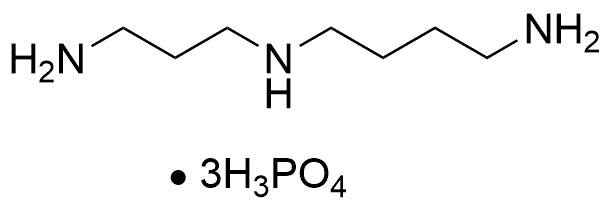Spermidine phosphate is widely utilized in research focused on:
- Cell Growth and Proliferation: This compound plays a crucial role in promoting cell growth, making it valuable in studies related to cancer research and regenerative medicine.
- Neuroprotection: It has been shown to provide protective effects on neurons, which is beneficial in neurodegenerative disease research, such as Alzheimer's and Parkinson's.
- Anti-Aging Research: Spermidine phosphate is linked to cellular autophagy, a process that helps in cellular renewal, thus attracting interest in longevity and anti-aging studies.
- Biotechnology Applications: In the field of biotechnology, it is used to enhance the efficiency of various bioprocesses, including fermentation and enzyme production.
- Pharmaceutical Development: Its unique properties make it a candidate for developing new therapeutic agents, particularly in the areas of oncology and neurology.
General Information
Properties
Safety and Regulations
Applications
Spermidine phosphate is widely utilized in research focused on:
- Cell Growth and Proliferation: This compound plays a crucial role in promoting cell growth, making it valuable in studies related to cancer research and regenerative medicine.
- Neuroprotection: It has been shown to provide protective effects on neurons, which is beneficial in neurodegenerative disease research, such as Alzheimer's and Parkinson's.
- Anti-Aging Research: Spermidine phosphate is linked to cellular autophagy, a process that helps in cellular renewal, thus attracting interest in longevity and anti-aging studies.
- Biotechnology Applications: In the field of biotechnology, it is used to enhance the efficiency of various bioprocesses, including fermentation and enzyme production.
- Pharmaceutical Development: Its unique properties make it a candidate for developing new therapeutic agents, particularly in the areas of oncology and neurology.
Documents
Safety Data Sheets (SDS)
The SDS provides comprehensive safety information on handling, storage, and disposal of the product.
Product Specification (PS)
The PS provides a comprehensive breakdown of the product’s properties, including chemical composition, physical state, purity, and storage requirements. It also details acceptable quality ranges and the product's intended applications.
Certificates of Analysis (COA)
Search for Certificates of Analysis (COA) by entering the products Lot Number. Lot and Batch Numbers can be found on a product’s label following the words ‘Lot’ or ‘Batch’.
*Catalog Number
*Lot Number
Certificates Of Origin (COO)
This COO confirms the country where the product was manufactured, and also details the materials and components used in it and whether it is derived from natural, synthetic, or other specific sources. This certificate may be required for customs, trade, and regulatory compliance.
*Catalog Number
*Lot Number
Safety Data Sheets (SDS)
The SDS provides comprehensive safety information on handling, storage, and disposal of the product.
DownloadProduct Specification (PS)
The PS provides a comprehensive breakdown of the product’s properties, including chemical composition, physical state, purity, and storage requirements. It also details acceptable quality ranges and the product's intended applications.
DownloadCertificates of Analysis (COA)
Search for Certificates of Analysis (COA) by entering the products Lot Number. Lot and Batch Numbers can be found on a product’s label following the words ‘Lot’ or ‘Batch’.
*Catalog Number
*Lot Number
Certificates Of Origin (COO)
This COO confirms the country where the product was manufactured, and also details the materials and components used in it and whether it is derived from natural, synthetic, or other specific sources. This certificate may be required for customs, trade, and regulatory compliance.

